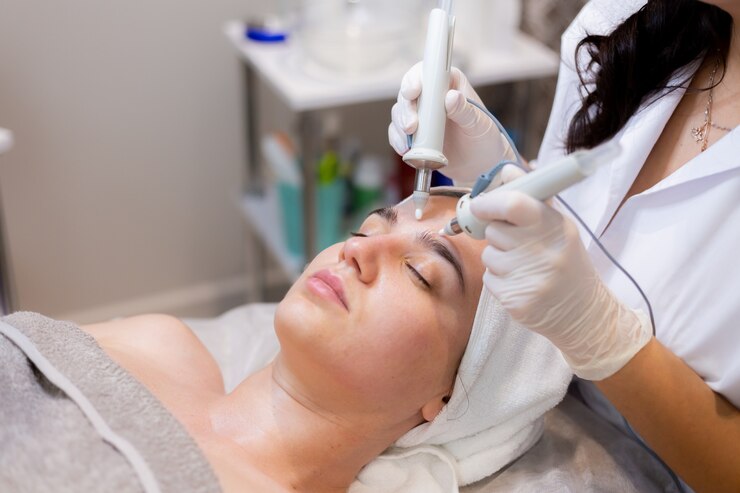
Select City
Hydrafacial treatment has become a popular choice in Indian dermatology clinics for people seeking effective skin improvement without harsh procedures. The non-invasive hydrafacial can address various skin issues, such as blackheads and dullness, and dehydration simultaneously. This process involves gentle exfoliation, intense cleansing, and serum infusion, providing visible effects.
Hydrafacial treatment has become a popular choice in Indian dermatology clinics for people ... Read More




Free Consultation

Free Cab Facility

No-Cost EMI

Support in Insurance Claim

1-day Hospitalization

USFDA-Approved Procedure
Choose Your City
It help us to find the best doctors near you.
Delhi
Kochi
Delhi
Gurgaon
Noida
Ahmedabad
Bangalore
Hydrafacial is an advanced facial procedure that cleanses, polishes, extracts, and moisturizes skin in a single session. Unlike traditional facials that rely on manual techniques, it involves a medical-grade device with vortex-fusion technology to perform all steps efficiently. The HydraFacial MD machine features a spiral-tip design that removes impurities while simultaneously infusing the skin with serums rich in antioxidants, peptides, and hyaluronic acid.
This treatment targets acne, fine lines, dullness, pigmentation, and congestion. It suits most skin types and is commonly used by both teenagers and adults, though those with active skin conditions should consult a dermatologist first. Performed only in clinical settings under professional supervision, hydrafacial treatment ensures a safe and effective experience tailored to individual skin needs.

Fill details to get actual cost
The hydrafacial treatment follows a systematic multi-step process to cleanse, exfoliate, and hydrate the skin. Each step prepares the skin for the next phase, ensuring maximum effectiveness and comfort during the procedure. The complete process takes 30-45 minutes per session.
The procedure of cleansing begins with using a specialized spiral tip that removes surface impurities, makeup residue, and environmental pollutants. This rotating brush tip removes the top layer of dead skin cells and cleanses the skin at the same time. The process is painless and prepares the skin for deeper treatment by opening the pores and removing surface barriers.
During this step, a mild solution with glycolic acid and salicylic acid is placed on the skin. Glycolic acid exfoliates the surface, dissolving the bonds that hold dead skin cells together, whereas salicylic acid reaches into the pores deeper to dissolve the oil and debris in the pores. Unlike traditional peels, this form of chemical exfoliation is gentler and only mildly irritating, and it is highly effective at clearing impurities.
The vortex-suction technology removes blackheads, whiteheads, and excess sebum (natural oil) from pores. This vacuum-assisted extraction is more hygienic and comfortable than manual extraction methods. Dermatologists can increase or decrease the suction strength, depending on the skin sensitivity, to efficiently extract impurities without wounding nearby skin.
The same vortex technology is used to infuse antioxidant-rich serums with hyaluronic acid, peptides, and vitamins into the skin. This step hydrates the skin, offers anti-aging protection, and shields against environmental aggression. The serums are personalized depending on what skin issue one might have, like acne, pigmentation, or aging.
Some clinics offer LED light therapy as an added step to enhance treatment results. Red light therapy stimulates collagen production and reduces inflammation, while blue light targets acne-causing bacteria. This optional add-on extends the session by 10-15 minutes but provides more therapeutic benefits for specific skin concerns.
The hydrafacial benefits are backed by clinical evidence and used by dermatologists for routine skincare. It combines cleansing, exfoliation, hydration, and antioxidant delivery in a single session. Many patients see improvements in hydration and surface texture, but deeper issues (like pigmentation, acne scars, or fine lines) need multiple sessions.
There are different Hydrafacial treatment options available to address specific skin concerns and budget requirements:
Clinics may customize the session further based on individual skin concerns.
Diet & Lifestyle Consultation
Post-Surgery Follow-Up
Free Cab Facility

24*7 Patient Support
Hydrafacial treatment works well for most skin types and age groups, but individuals with specific skin conditions should first consult a dermatologist. Its gentle, non-invasive nature makes it suitable for people who can’t handle harsher procedures. Clinical studies confirm its safety and effectiveness for teenagers, adults, and older patients.
Hydrafacial is commonly recommended for:
Teenagers dealing with hormonal acne, adults maintaining skin health, and older individuals targeting texture or hydration can all benefit. Consult a certified dermatologist before beginning treatment to ensure it’s appropriate for the specific skin type and condition.
There are some medical issues and skin conditions when hydrafacial treatment is inappropriate. Dermatologists evaluate every individual to prevent complications and ensure safe application.
Hydrafacial should be avoided by those with:
All medications, recent procedures, and skin sensitivities should be discussed in a pre-treatment consultation. Patients who have infections or unstable skin conditions should wait until the skin heals completely to receive treatment. This ensures optimal results and avoids potential adverse reactions.
The recommended frequency of hydrafacial sessions depends upon skin issues and objectives. Dermatologists usually individualize the schedules depending on observations and skin reactivity.
| Skin Concern | Frequency of Sessions |
| Normal Skin | Every 4–6 weeks |
| Acne-prone Skin | Every 2–3 weeks |
| Sensitive Skin | Every 6–8 weeks |
| Ageing Skin | Once a month |
This frequency supports maintenance of hydrafacial benefits over time with a low risk, but adjustments is necessary based on individual progress.
A hydrafacial treatment is well-tolerated, and most side effects are mild and short-term. Common side effects of hydrafacial may include:
Serious side effects are rare, especially when handled by trained professionals using approved methods. Any persistent irritation, swelling, or unexpected skin responses should be reported to a dermatologist immediately.
The hydrafacial price in India varies based on clinic location, equipment quality, and additional services included. Metro cities typically charge higher rates due to advanced technology and trained staff availability.
| City | Price Range (INR) |
| Delhi | ₹3,500–₹10,000 |
| Mumbai | ₹4,000–₹12,000 |
| Bangalore | ₹4,000–₹11,000 |
| Chennai | ₹3,500–₹8,500 |
| Hyderabad | ₹3,500–₹13,000 |
Hydrafacial is often compared to treatments like chemical peels, microdermabrasion, and oxygen facials, all improve hydration and skin clarity. These options are different in technique, downtime, and how they approach concerns like breakouts, rough texture, or early signs of aging.
| Feature | Hydrafacial | Chemical Peel | Microdermabrasion | Laser Resurfacing |
| Invasiveness | Non-invasive | Mild to moderate | Mild | Moderate to high |
| Recovery Time | None | 1–7 days | 1–3 days | 5–10 days |
| Suitable for Skin Types | All skin types | Mainly oily/acne | Dull or rough skin | Ageing or scarred |
| Skin Brightening | Yes | Yes | Partial | Yes |
| Cost (per session) | ₹2,000–6,000 | ₹1,200–6,500 | ₹2,500–5,000 | ₹2,000–40,000 |
Hydrafacial results are often visible within 24 hours, with smoother texture, improved hydration, and a brighter appearance due to exfoliation and serum infusion. Blackhead removal and reduced pore congestion are noticeable after the first session, while antioxidant serums continue to nourish the skin over time.

Visible improvements tend to build after two or three hydrafacial sessions, especially for mild concerns like dullness or blackheads. Monthly sessions are often recommended to maintain hydration, texture, and radiance. However, since Hydrafacial targets surface-level issues, it’s not made for treating deep wrinkles or significant scarring, so expectations should align accordingly.
Dermatologists adjust the hydrafacial treatment based on a comprehensive skin assessment and patient goals. Dermatologists incorporate advanced serums and boosters during the infusion phase to address particular skin conditions. These specialized formulations contain higher concentrations of active ingredients designed to target specific concerns more effectively than standard hydrating serums.
| Skin Concern | Suggested Add-on/Protocol |
| Acne-prone skin | Clarifying boosters with salicylic acid |
| Pigmentation issues | Brightening serum with kojic acid and glycolic acid |
| Aging skin concerns | Antioxidant serum with peptides and LED therapy |
| Sensitive skin | Gentle hydrating serums without acids |
| Sun damage | Vitamin C boosters with antioxidant protection |
Effective preparation and thoughtful aftercare enhance the results of a hydrafacial by supporting skin balance and barrier protection. The skin becomes more sensitive during this period, making product selection and timing important to avoid irritation and extend the glow achieved during the session. Following these guidelines maintain treatment results and protects the newly treated skin from environmental damage and irritation:
Pre‑Treatment:
Post‑Treatment:
Patients should contact their dermatologist immediately if they experience persistent redness, unusual swelling, or other concerning symptoms beyond the expected period.
Selecting an appropriate clinic for hydrafacial treatment requires evaluation of factors such as medical credentials, equipment quality, and safety protocols.
Choosing a medically supervised clini c with certified equipment and clear protocols ensures safer and more effective results.
Hydrafacial treatment offers a safe and effective way to maintain the skin. It delivers proven results for common skin issues. The reasonable hydrafacial price and minimal downtime make it easy to use regularly. The benefits of hydrafacial include better hydration, clearer pores, and improved skin texture through a gentle, non-invasive process.
Book a session with a licensed dermatologist to personalize your treatment and maintain long-term skin health.
The cost of a hydrafacial session in India ranges from ₹2,000 to ₹ 6,000, depending on location and clinic quality. Premium clinics may charge more for sessions that include advanced serums, LED therapy, and extended consultation.
Most dermatologists recommend one session every four weeks for maintenance. For targeted concerns like pigmentation or acne, an initial series of 3 to 4 sessions spaced 2 to 3 weeks apart may be advised.
Yes. Skin often looks more hydrated, radiant, and smooth within 24 hours. While the first session offers visible improvement, consistent treatments yield better long-term results.
It is suitable for mild acne and congested pores. However, it should be avoided during active cystic breakouts or open lesions. A dermatologist can assess suitability and suggest modifications if needed.
Mild redness and tightness can occur shortly after treatment and usually resolve within a few hours. Peeling is uncommon, as hydrafacial is gentler than chemical peels.
Hydrafacial is generally safe during pregnancy when customised properly. However, certain ingredients like salicylic acid may need to be avoided. Always consult a dermatologist before scheduling.
No. Most patients find the procedure comfortable. The extraction phase involves gentle suction, and the acid application may cause a mild tingling sensation, but there is no significant discomfort.
A deluxe session includes the standard cleansing, exfoliation, and hydration steps, along with either LED light therapy or booster serums selected for specific concerns like pigmentation or aging.
Yes. Teenagers with oily skin, blackheads, or mild acne can benefit from a hydrafacial. Parental consent and dermatologist supervision are recommended for safe treatment planning.
No. Hydrafacial is considered a cosmetic procedure and is not covered under health insurance plans in India. Patients must pay the full cost out of pocket.
 Medically reviewed by:
Medically reviewed by:
.svg)